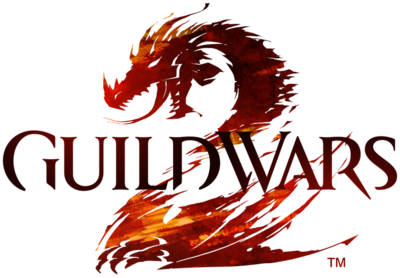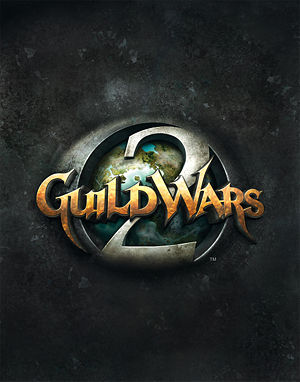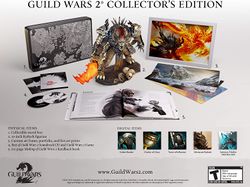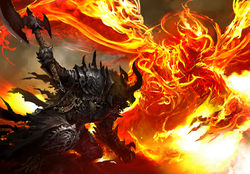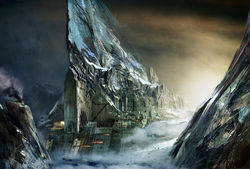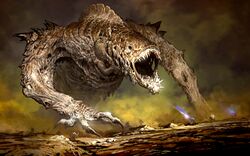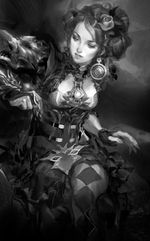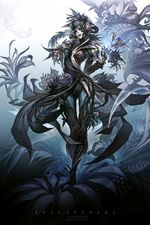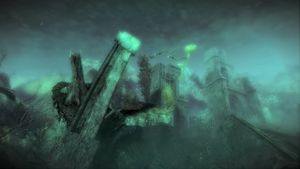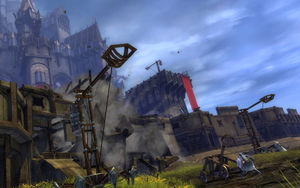Guild Wars 2
Guild Wars 2 is the sequel to the Guild Wars series of games by ArenaNet. Guild Wars 2 was released on August 28, 2012.[1] It has been in development since 2006. Many features have integrated into the game which align it with traditional MMORPGs, such as a persistent world and a level cap of 80, but the game has been described by ArenaNet as having non-traditional elements as well, because "it doesn't make you spend hours preparing to have fun rather than just having fun."
This article provides an overview of the features of Guild Wars 2. For more detailed information, consult the fan FAQ or other articles available on this wiki.
Development progress and release information[edit]
Guild Wars 2 began development in the middle of 2006; it was first announced to the public in 2007. It began closed beta testing on 16 December 2011.[2] On 23 January 2012, ArenaNet announced that Guild Wars 2 would launch by the end of that year, following beta tests throughout March and April.[3] On 28 June, ArenaNet announced that the game would launch on 28 August 2012.
ArenaNet began offering playable demos to convention attendees starting with Gamescom in 2010. In each of these demos the game systems presented to players have increased and shown evolution and change. Considerable amount of gameplay footage from these conventions can be found on YouTube.
Pre-purchase for Guild Wars 2 started on April 10th, 2012 allowing players to purchase one of three versions of the game before its launch: Digital Edition, Digital Deluxe Edition, and Collector's Edition.
The game sold over two million copies in its first two weeks.[4][5] By August 2013, the peak player concurrency had reached 460,000.[6] By August 2015, over 5 million copies had been sold, at which point the base game became free-to-play.[7] By August 2021, over 16 million accounts have been created.[8]
By March 2022, one month after the release of End of Dragons, the expansion has already managed to outsell Path of Fire, the previous expansion, with the game's active players more than doubling since 2019.[9]
In August 2022, Guild Wars 2 launched on Steam.[10]
Purchasing[edit]
- Primary article: Account#Free accounts
As of August 29, 2015 the original Guild Wars 2 content is free to play and does not require an initial purchase of the game or a subscription fee to play. Purchasable content is available in the form of expansions and episodical updates, labelled as Living World seasons, that expand the base/original game content. Guild Wars 2 has micro-transactions similar to those offered in Guild Wars.[11]
The core game can be freely acquired through the official website. Even though there is no monetary cost, an account is required to play. Free-to-play accounts have several restrictions, which are lifted with an expansion purchase. Players that purchased the game prior to August 29 2015 are considered to have a Guild Wars 2 "Core" account without the free-to-play restrictions. See guildwars2.com for further information.
There is a "Partner Program" through which new purchases at current prices can also benefit your favorite content creator. "Content creators" are those who run a podcast, fansite, video channel or live stream channel which features GW2 news, how-tos, fan-art, etc. See Arenanet Partner Program for a list of current partners or to apply to become a partner. That site includes a short video describing the partner program.
Expansions[edit]
There have been four substantial expansions released, each of which was available for purchase at the time of their release. A fifth expansion is slated for release at some point in the future.[12]
- Guild Wars 2: Heart of Thorns — Includes Heart of Maguuma maps and story. Required for Living World Season 3.
- Guild Wars 2: Path of Fire — Includes Crystal Desert maps and story. Required for Living World Season 4 and The Icebrood Saga.
- Guild Wars 2: End of Dragons — Includes Cantha maps and story.
- Guild Wars 2: Secrets of the Obscure — Includes Horn of Maguuma& Nayos maps and story.
- Untitled Fifth Expansion — announced on August 22, 2023, set to be released in 2024.[12]
- Untitled Sixth Expansion — future sixth expansion pack. Slated for release in 2025.[13]
As of August 30th 2019, Heart of Thorns is included for free when the second expansion, Path of Fire is purchased.
The currently available editions of the game to new players are therefore:
- Guild Wars 2 Core - Free to play which provides access to core Tyria maps, has limitations on certain features, such as the ability to use the Trading Post and Map Chat.
- Also includes all episodes of Living World Season 1 since their rerelease concluded on November 8, 2022.
- Path of Fire and all preceding expansions:
- Standard Edition
- See Path of Fire#Purchasing for the full details on what is included.
- End of Dragons expansion:
- Standard Edition
- Deluxe Edition
- Ultimate Edition
- End of Dragons and all preceding expansions:
- Elder Dragon Saga — Collection Standard Edition
- Elder Dragon Saga — Collection Deluxe Edition
- Elder Dragon Saga — Collection Ultimate Edition
- See End of Dragons#Purchasing for the full details on what is included in the different End of Dragons editions.
- End of Dragons, all preceding expansions and Living World Seasons 2-5:
- Elder Dragon Saga — Complete Collection
- Living World Season 1 is available for free to all players.
- Secrets of the Obscure expansion:
- Standard Edition
- Deluxe Edition
- Ultimate Edition
- See Secrets of the Obscure#Purchasing for the full details on what is included in the different Secrets of the Obscure editions.
Historical Guild Wars 2 Editions[edit]
These editions of Guild Wars 2 are no longer sold by ArenaNet as of the release of Heart of Thorns, but any existing serial keys may still be redeemed.
- Pre-Order
- 1 day Head Start
- Standard Edition Pre-Purchase - limited quantity (through select retailers and the official website)
- Access to all Guild Wars 2 Beta Weekend Events
- 3 days Head Start
- Hero's Band
- Boxed Standard Edition (only through retailers)
- Heroic Edition, offering full base game and several bonus items.
While the Heroic Edition is no longer available for purchase, codes are often distributed during online promotions or handed out at conventions as physical codes.
- Deluxe Edition, which includes special in-game features: a miniature, several one-time or short-term use items, and a special elite skill.
- Collector's Edition, a disc-version of the above, which also comes a 10-inch Rytlock figurine, 112 page Making of Guild Wars 2 book, Best of Guild Wars 2 Soundtrack CD, art portfolio and five art prints, and a custom art frame. (Sold out in the Arenanet shop, some retailers still have this in stock)
| Items | Boxed | Heroic Edition | Deluxe | Collector's Edition |
|---|---|---|---|---|
| Guild Wars 2 Game | 1 |
1 |
1 |
1 |
| Suit of Legacy Armor | 0 |
1 |
1 |
1 |
| Mithril Box | 0 |
1 |
1 |
1 |
| 10 Experience Boosters | 0 |
1 |
1 |
1 |
| Mistfire Wolf Elite Skill | 0 |
0 |
1 |
1 |
| Miniature Rytlock (Account Bound) | 0 |
0 |
1 |
1 |
| Golem Banker | 0 |
0 |
1 |
1 |
| Chalice of Glory | 0 |
0 |
1 |
1 |
| Tome of Influence | 0 |
0 |
1 |
1 |
| 10-inch figurine of Rytlock | 0 |
0 |
0 |
1 |
| 112 page Making of Guild Wars 2 book | 0 |
0 |
0 |
1 |
| Custom Art Frame | 0 |
0 |
0 |
1 |
| Art Portfolio and Five Art Prints | 0 |
0 |
0 |
1 |
| Best of Guild Wars 2 Soundtrack CD | 0 |
0 |
0 |
1 |
Digital Distribution
Two versions of the game were available in the past, but were discontinued.
- Digital Edition
- Digital Deluxe Edition (There is still a Digital Deluxe Edition available, but the content of the digital package has been changed, The one in the table below reflects the old version)
| Items | Digital Edition | Digital Deluxe Edition |
|---|---|---|
| Guild Wars 2 Game | 1 |
1 |
| Hero's Band (pre-purchase only) | 1 |
1 |
| 3-day headstart (pre-purchase only) | 1 |
1 |
| Mistfire Wolf Elite Skill | 0 |
1 |
| Miniature Rytlock (Account Bound) | 0 |
1 |
| Golem Banker | 0 |
1 |
| Chalice of Glory | 0 |
1 |
| Tome of Influence | 0 |
1 |
![]() Heart of Thorns Expansion: - Included Heart of Maguuma maps and story. Required for Living World Season 3
Heart of Thorns Expansion: - Included Heart of Maguuma maps and story. Required for Living World Season 3
- Pre-Purchase
- Access to All Beta Weekend Events
- Exclusive Title (Maguuma Trailblazer)
- Additional character slot (requires the account being upgraded to have been registered prior to January 23, 2015)
- Standard Edition ($49.99 / €44.99 / £34.99)
- Deluxe Edition ($74.99 / €74.99 / £59.99)
- Ultimate Edition ($99.99 / €99.99 / £79.99)
| Items | Standard | Deluxe | Ultimate |
|---|---|---|---|
| Guild Wars 2: Heart of Thorns (expansion) | 1 |
1 |
1 |
| Level-80 Boost | 1 |
1 |
1 |
| Shared Inventory Slot | 1 |
1 |
1 |
| Additional character slot | 0 |
1 |
1 |
| Miniature Revenant Rytlock | 0 |
1 |
1 |
| Revenant Finisher | 0 |
1 |
1 |
| Mordremoth's Bane Guild Decoration | 0 |
1 |
1 |
| Heart of Thorns Glider Skin | 0 |
1 |
1 |
| 4000 Gems ($50 / €50 / £42.50 value) | 0 |
0 |
1 |
![]() Path of Fire Expansion: - Included Path of Fire maps and story. Required for Living World Season 4
Path of Fire Expansion: - Included Path of Fire maps and story. Required for Living World Season 4
- Pre-Purchase[14]
- Standard Edition ($29.99 / €29,99 / £25.99)
- Deluxe Edition ($54.99 / €54,99 / £47.99)
- Ultimate Edition ($79.99 / €79,99 / £69.99)
| Items | Standard | Deluxe | Ultimate |
|---|---|---|---|
| Guild Wars 2: Path of Fire (expansion) | 1 |
1 |
1 |
| Guild Wars 2: Heart of Thorns (expansion)[15] | 1 |
1 |
1 |
| Level-80 Boost | 1 |
1 |
1 |
| Additional character slot | 0 |
1 |
1 |
| Identity Repair Kit | 0 |
1 |
1 |
| Spearmarshal's Presence | 0 |
1 |
1 |
| Lily of the Elon Permanent Pass | 0 |
1 |
1 |
| 4000 Gems ($50 / €50 / £42.50 value) | 0 |
0 |
1 |
Chinese release[edit]
- Primary article: Guild Wars 2 China
Guild Wars 2 (Chinese: 激战2; pinyin: Jīzhàn 2; lit. 'fierce battle 2') published by KongZhong in Mainland China was launched on 15 May 2014.
A massive event was held in Beijing during the Chinese launch. ArenaNet and KongZhong took the stage alongside China's biggest stars and a 30-foot statue of Rytlock Brimstone. Jike Juan Yi, also known as Summer, was the event's most prominent celebrity performer. Summer created a music video combining live action and game play to debut a Chinese version of the Guild Wars 2 anthem Fear Not This Night.
The game, which was originally released in China as a standalone client, is now distributed by Tencent via their client WeGame (as of 2020-06-16).
Differences between the original western release[edit]
- The Chinese version is completely separated and runs on different servers.
- Premium VIP membership known as Royal Club.
System requirements[edit]
| Component | Minimum System Requirements[16] for |
|---|---|
| Operating System | Windows® 7 or better (64 bit only) |
| Processor | Intel® Core 2 Quad 2.4 GHz Core i3 AMD Athlon 64 X2 |
| Video | NVIDIA® GeForce® 8800GTS ATI Radeon HD 2900 XT |
| Memory | 4 GB RAM |
| Storage | 70GB available HDD space |
| Internet | Broadband Internet connection |
| Input | Keyboard and mouse |
| DirectX | DirectX 11 |
| Component | Minimum System Requirements[16] for |
|---|---|
| Operating System | Windows® 7 or better (64 bit only) |
| Processor | Intel®i3 3.4 GHz AMD Athlon x4 3.8 GHz or better |
| Video | NVIDIA® GeForce® GTX 680 AMD Radeon HD 7970 |
| Memory | 8 GB RAM |
| Storage | 70GB available HDD space |
| Internet | Broadband Internet connection |
| Input | Keyboard and mouse |
| DirectX | DirectX 11 |
Characters[edit]
- Primary article: Character
There are two fixed aspects to any character created: race and profession.
The selection of one of five playable races determines the appearance and voice of the character and gives a flavor to the character in combat with versatile racial skills and through a personal storyline with the unique themes and history of the race. The selection of one of eight (nine with expansions) available professions determines most of what the character is capable of doing. It restricts the armor type wearable, but more importantly determines how the skill bar is built through the unique game mechanics of the profession, the weapons that can be wielded, and the skills and ability modifiers available. The profession abilities have been emphasized over racial abilities to make sure that each race is equally able to play each profession. Professions are roughly analogous to what most other MMOs refer to as character classes.
A character can be used to play any game mode available in Guild Wars 2: PvE, Structured PvP and World PvP. A player may still have multiple characters. The game is designed to be viable for both solo and group play.
Guild Wars 1 characters[edit]
Characters from the original Guild Wars cannot be migrated to play in Guild Wars 2, though some player achievements are translated through the Hall of Monuments, which grants titles and new items. Players also had the chance to reserve their character names up until July 31, 2012 before the game's launch.[23]
Combat[edit]
- Primary article: Combat
Combat in Guild Wars 2 is built around three facets: damage, control and support. Damage is simply decreasing the enemy's health, control is preventing the enemy from doing what it wants, and support consists of working together with allies. Each profession is able to perform any of these roles. While some professions may be better at an aspect than others, no character is a specialist in a particular role. For example, there is no profession which focuses on the healing aspect of support - the best healing abilities available in the game are the compulsory self healing skills.
Combat is designed to be tactical and dynamic; items in the environment can be used as weapons, body position can affect skills, and skills which allies use can interact with the player to create new effects. Players can dodge enemy attacks to avoid damage and even what is done at the edge of death can change the outcome of the fight dramatically.
Player versus Environment[edit]
- Primary article: Player versus Environment
Guild Wars 2 features a zoned persistent game world which is split across multiple game servers.
Guild Wars 2 has a significantly larger world than that of Guild Wars.[24] Underwater explorable areas are a significant part of some zones, some of which have over half of the area underwater. These underwater areas are designed to be easily accessible and fun places to explore for all players so there aren't any breath meters or time limits. The underwater areas have new friendly races and their own events.
Event system[edit]
- Primary article: Dynamic event
Instead of a traditional quest system, there are dynamic events. As the world is explored, objectives become revealed by occurrences around the player. For example, a town under attack is identifiable by the destruction caused by enemies and townspeople fleeing. Participating in defending the town gives rewards whether the event succeeds or fails. There are over 1500 events that can occur in a dynamic system based on player action or inaction in the world. Participation in these events thus affects the state of the world (f.e. the availability of merchants). The events that occur are sometimes influenced by the latest available story updates, causing the events to change accordingly.
Major part of the event system are the meta events, which are chains of events telling a story of an explorable zone, with map meta events spanning across the whole map. Many world bosses, which are powerful creatures requiring multiple players and offering valuable rewards, are often the culminations of these meta events.
Festivals are annual celebrations that feature a large number of events and activities to partake in within specific locations. The festivals take place within fixed periods of the year for example, the Halloween festival takes place between late October to early November.
Personal story[edit]
- Primary article: Personal story
In the 250 years since the events of Guild Wars, the Elder Dragons have awoken. As massive forces of nature, these dragons have wrought destruction across the continent of Tyria, forever changing its face and its inhabitants. The player is thrown into the midst of this destruction. Each character has its own biography which affects the story and how non-player characters react. As the game progresses, organizations can be joined and situations approached in different ways; these influences change the experience of the story as it advances towards the final confrontation with the Elder Dragon, Zhaitan. There are therefore millions of different story permutations possible.
Much of the story between Guild Wars and Guild Wars 2 is elaborated on in the novels set in the intervening years; Ghosts of Ascalon, Edge of Destiny, and Sea of Sorrows.
Dungeons[edit]
- Primary article: Dungeon
Partially tied to the personal story, though unrequired to understand it, is a series of endgame instances taking place in various locations across central Tyria. They are intended for a full party of five players, though overtime it has become common to see players "low-manning" them for an added challenge. Upon a player's first experience with a dungeon, they will play the story mode. This mode introduces the location, its conflict, and the connection to the personal story. On later attempts, players are able to enter explorable mode, where they are offered various paths to explore the aftermath of their actions in the story mode.
Fractals of the Mists[edit]
- Primary article: Fractals of the Mists
Regarded as an evolution of traditional dungeons, Fractals take place in a proto-reality called the Mists. The Fractals themselves represent glimpses into locations that can exist anywhere in time and space, some possibly outside Tyria's reality. These instances allow for 5-person parties and are short, repeatable, and rewarding. Having a progressive difficulty system and "instabilities" that provide unique challenges, Fractals have become the main form of endgame content in the game.
Strike Missions[edit]
- Primary article: Strike Mission
Intended as a bridge between Fractals and raids, strike missions are single encounter-based instances that introduce players to raid-style combat mechanics on a more approachable level. Strike missions also introduce players to endgame content allowing for 10-person squads, allowing more party diversity and specialization.
Raids[edit]
- Primary article: Raid
Raids are the most difficult endgame content system present in Guild Wars 2 presently. They utilize 10-person parties and allow players to participate in a series of intense and finely-tuned encounters as they uncover the deepest secrets of Tyria's past.
Crafting[edit]
- Primary article: Crafting
Guild Wars 2 has a robust crafting system of eight different disciplines which can be changed at any time without losing progress. Leveling the disciplines is designed to allow the player to craft items for themselves as they progress through the game without grinding for specific gear types. Gathering doesn't prevent other players from also gathering from the same resource. These resources will also respawn after a specific amount of time.
Jumping Puzzles and Mini-dungeons[edit]
Jumping Puzzles are basically courses requiring players to utilize their platforming and puzzle-solving skills to traverse the jumping puzzle and reach the end point. Mini-dungeons are similar to dungeons but are much shorter and don't require players to form a party to explore. Unlike dungeons, mini-dungeons and jumping puzzles take place within the open world map instead of instances.
Activities[edit]
Mini-game activities are provided in major towns and Lounges. Other mini-game interactions, like Belcher's Bluff and costume brawl allow players to face off against each other in unique ways, and are prompted with items that can be used almost anywhere in the open world.
Player versus Player[edit]
Structured PvP[edit]
- Primary article: Structured PvP
There are two main forms of organized PvP: a tournament based game with evenly organized teams, and pick-up play where individuals or groups can hot-join a map depending on a variety of settings similar to competitive MOBAs and first-person-shooters. Players entering organized PvP get a fixed level and any items necessary to ensure an even footing.
World versus World[edit]
- Primary article: World versus World
World versus World is a persistent competitive player versus player mode featuring objective-oriented battles between three matched servers over a one-week period on the Eternal Battlegrounds, Alpine Borderlands, and Desert Borderlands maps. Players are able to enter using the World vs. World panel upon reaching level 31 and are scaled up to level 80 however, unlike Structured PvP, players use the same equipment and skill unlocks as in PvE. Matches are divided into smaller two hour "skirmishes" during which each team accumulates points for their team by holding and upgrading territory objectives, as well as killing enemy players. Rewards are earned through killing enemy NPCs and players, as well as every five minutes through the Skirmish reward track, a player selected WvW Reward Track, and increasing WvW Rank through earning World Experience .
Living World[edit]
- Primary article: Living World
Guild Wars 2 presents much of its story through a series of updates between expansions called the Living World. This includes major story updates that are usually accompanied by new map releases, along with minor updates such as side stories and new events and ambient changes that reflect developments in the story. While the system was largely experimental at first, leading to Season One being currently unavailable, the following seasons remain accessible to new players. Future updates are free to players so long as they log in during each episode's introductory period.
Guilds[edit]
- Primary article: Guild
A player may link up to 5 guilds to their account and may choose which guild they would like to represent on any character at any time while being able to chat in all of them at the same time. Only when "representing" a specific guild do they have access to the guild bank and any other guild perks. Some options available to support guilds include various guild missions and material donations. One of the ultimate goals of a guild is to fully extend (and decorate) their guild hall, which will provide them with more benefits, such as new merchants.
Game engine[edit]
Guild Wars 2 uses an engine that was originally derived from the Guild Wars engine but has continuously evolved over the years to the point it is now almost completely different,[25][26] but has retained some specialized libraries hand-coded in assembly, such as vector math.[27]
Unlike the Guild Wars engine, Guild Wars 2 includes support for true 3D environments, more detailed environments and models, better lighting and shadows, new animation and effects systems, plus new audio and cinematics engines and a more flexible combat and skill-casting system.[28] It uses Havok to provide destructible environment and ragdoll animation of creatures[29] and Umbra's occlusion culling technology.[30]
While the game client has well optimized art assets and aggressive culling, it is still CPU-bound on anything above low-spec GPUs because the nature of being a MMO leads to many CPU-intensive tasks such as animating large amounts of characters on the screen at the same time, unique particle effects, or decoding gigabytes of assets as the player moves through the environment.[31]
Movement and combat[edit]
The game doesn't offer "click-to-move" control to player characters.[32] The game is capable of auto-pathing but it is used mostly by mobs, NPCs, player pets and certain PC and mount movement skills (leaps, teleports etc.)
The combat uses a combination of action combat and target-lock, typically in third person, with cross-hair target mode as an option. Ground markers are used for AoE attacks but non-AoE attacks require the player to observe and react to unique animations and sounds. There's no body-blocking. As expected of action combat, weapon range, obstructions, terrain, positioning, maneuvering tactics, roll-dodge and crowd-control all play an important role. Most notably, the PC cannot manipulate mob aggro (some aggro mechanics are available in some endgame instances) and the mobs will switch targets on the fly depending on a wide variety of factors, which means PCs have to keep moving, cooperate and react on a case-by-case basis in order to survive.
PCs can jump and traverse the landscape freely (with fall damage). The freedom of movement has in fact been greatly optimized to the point that complex platformer-style jumping puzzles are a common attraction. This freedom of movement has also translated to player mounts, which capitalize on environment interaction and interesting movement abilities to engage in mount puzzles, mount racing and mount-only access to some areas.
Day and night[edit]
- Primary article: Day and night
The game uses a 2-hour day-night cycle: day lasts for 70 minutes, night for 40 minutes, with dawn and dusk taking 5 minutes each. Some events only begin during one of these time periods, some NPCs only appear at certain times, and some food and equipment confers bonuses during either night or day. In addition, the explorable paths of five dungeons and six Fractals of the Mists always take place during the night; the others are always during the day. Maps can look completly different during daytime and nighttime.
Weather and environment[edit]
- Primary articles: Weather, Environmental hazard
There are weather patterns, and the interiors of many buildings in the environment are accessible. For the most part weather is decorative as it has no effect on combat, though it may trigger events in certain areas. However, there are environmental hazards that can influence movement or damage you (i.e. walking slower in quicksand, lava burning, slipping on icy surfaces, being dragged by strong gales etc.)
Water can be waded in up to a certain depth, after which the player character switches to surface swimming or can submerge for full underwater exploration. Underwater environments are large and fully populated with mobs, NPCs, structures, interactive events and items and have specific combat, movement capabilities, player pets and mounts.
Music[edit]
Jeremy Soule, composer for the Guild Wars series (and many other games) returned to compose the soundtrack for Guild Wars 2. Since the game's release, additional music has been composed by Maclaine Diemer, Stan LePard, and Lena Raine. Starting with the soundtrack for Shadow of the Mad King (Halloween 2012) most tracks can be found on Arena Net's soundcloud.
See also[edit]
- Guild Wars, the previous game in the Guild Wars franchise.
- Guild Wars 2: Heart of Thorns, the first expansion for Guild Wars 2.
- Guild Wars 2: Path of Fire, the second expansion for Guild Wars 2.
- Guild Wars 2: End of Dragons, the third expansion for Guild Wars 2.
- Guild Wars 2: Secrets of the Obscure, the fourth expansion for Guild Wars 2.
- Hall of Monuments, which bestows rewards earned by Guild Wars players to their Guild Wars 2 characters.
- Game credits for the original release of Guild Wars 2.
External links[edit]
- Official Guild Wars 2 website
- Guild Wars 2 forum
- Guild Wars 2 support
- Official China Guild Wars 2 website
References[edit]
- ^ Guild Wars 2: Get Ready, ArenaNet's channel on YouTube
- ^ I'm a Guild Wars 2 Developer: AMA about professions, Reddit
- ^ Welcome to the Year of the Dragon, ArenaNet blog
- ^ Guild Wars 2 sales now over 2 million units worldwide, VideoGamer.com
- ^ 'Guild Wars 2' Sales Break Two Million Mark, Inquisitr.com
- ^ Guild Wars 2 turns one, has shifted 3.5 million copies, VG247.com
- ^ ArenaNet explains Guild Wars 2 going free, and the addition of raids, Eurogamer.net
- ^ Celebrating Nine Years of Guild Wars 2, GuildWars2.com
- ^ ArenaNet Studio Update: The Future of Guild Wars 2, GuildWars2.com
- ^ Studio Update: Guild Wars 2 Tenth Anniversary and Steam Launch on August 23, GuildWars2.com
- ^ Play For Free Today, GuildWars2.com
- ^ a b Guild Wars 2: Secrets of the Obscure Launches Today, GuildWars2.com
- ^ GGuild Wars 2 Q&A – ArenaNet on Switch to Yearly Expansions, Secrets of the Obscure Learnings, and 2024 Updates, https://wccftech.com/
- ^ Prepurchase Guild Wars 2: Path of Fire, GuildWars2.com
- ^ Guild Wars 2: Heart of Thorns Is Free with Guild Wars 2: Path of Fire, GuildWars2.com (As archived on archive.org.)
- ^ a b Minimum System Requirements, help.guildwars2.com
- ^ Guild Wars 2, buy.guildwars2.com
- ^ a b Path of Fire & Heart of Thorns, buy.guildwars2.com
- ^ End of Dragons, buy.guildwars2.com
- ^ Elder Dragon Saga — Collection, buy.guildwars2.com
- ^ Elder Dragon Saga — Complete Collection, buy.guildwars2.com
- ^ Secrets of the Obscure, buy.guildwars2.com
- ^ Reserve Your Guild Wars Character Name for Guild Wars 2 by July 31, ArenaNet blog.
- ^ Pure Artistic Vision - A Guild Wars 2 Concept Art Q&A with Daniel Dociu, Ten Ton Hammer
- ^ Mike Popoloski (ArenaNetMike) comment about engine evolution from Guild Wars to Guild Wars 2, during a Reddit AMAA in October 2012, Reddit
- ^ James Wright (ArenaNetJamesW) comment about how long the engine has taken to develop, during a Reddit AMAA in October 2012, Reddit
- ^ Mike Popoloski (ArenaNetMike) comment about inherited engine libraries, during a Reddit AMAA in October 2012, Reddit
- ^ GC 2009: Guild Wars 2 - First Details and Q&A, IGN
- ^ Important Guild Wars 2 Questions Answered, ZAM
- ^ ArenaNet® Licenses Umbra for Guild Wars 2, Umbra Software
- ^ James Wright (ArenaNetJamesW) comment on the game client being CPU-bound, during a Reddit AMAA in October 2012, Reddit
- ^ Guild Wars 2 (magazine article transcription), PC Gamer
